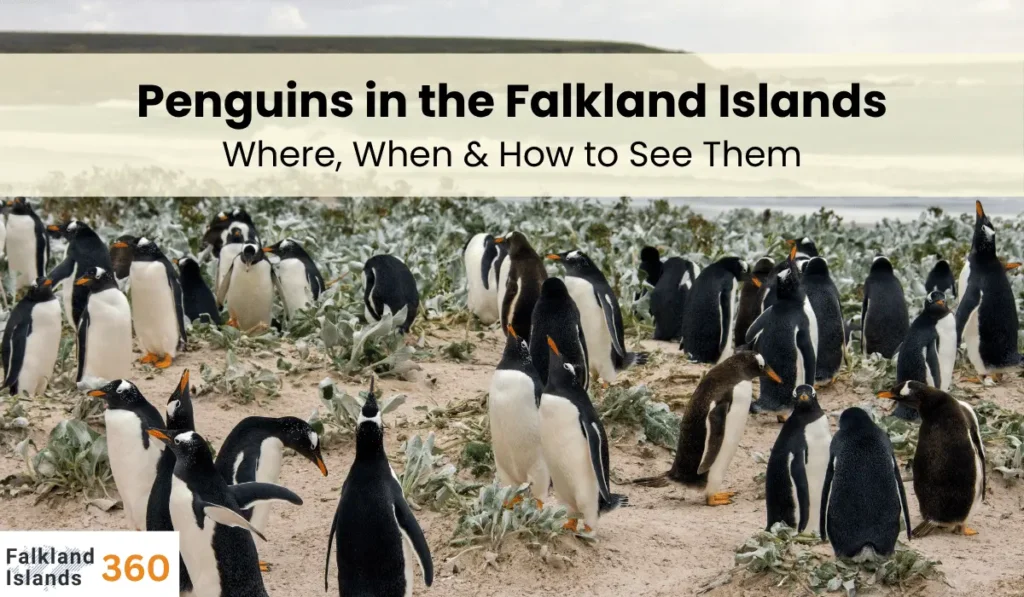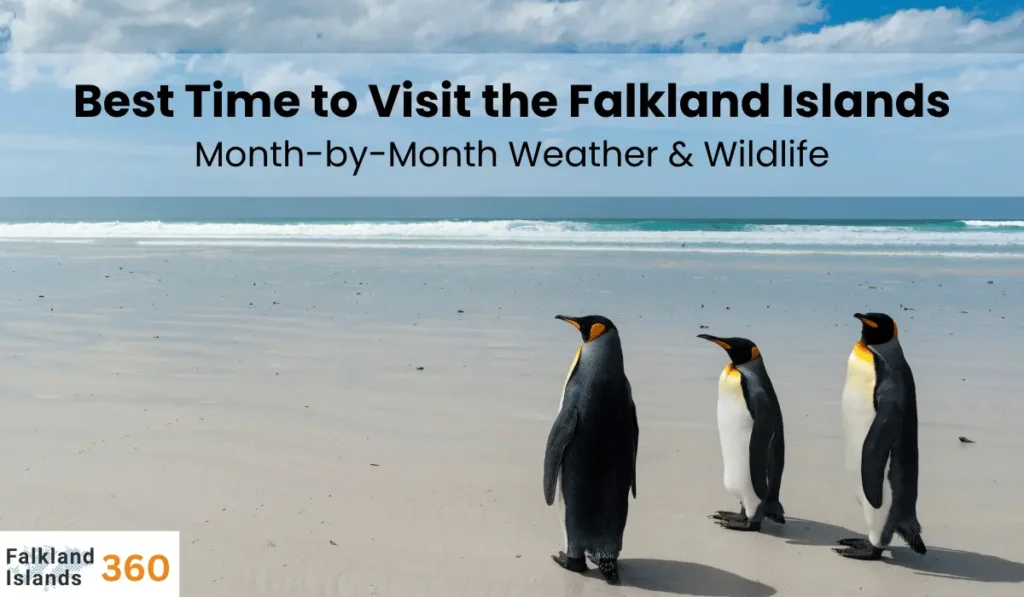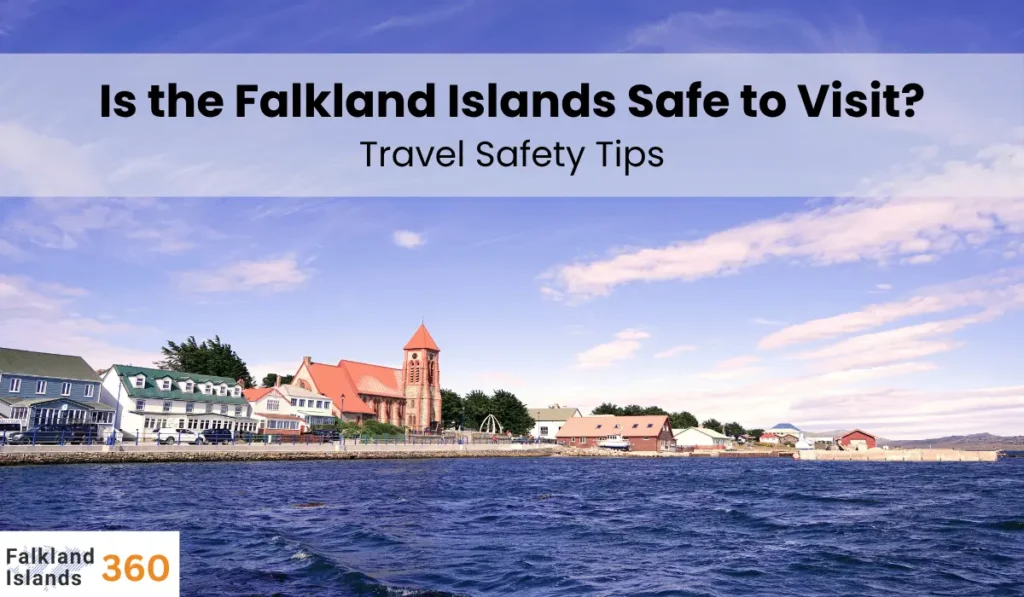The Falkland Islands are famous for penguins. Sometimes even nicknamed “Penguin Islands,” the archipelago hosts all five breeding species of penguins, such as Gentoo, King, Magellanic, Macaroni and Rockhopper, making it one of the best places to see these birds. Around one million penguins nest here each summer on sandy beaches and green shores.
The largest global population of Gentoo penguins calls the Falklands home. In summer, colonies are large and confident, offering excellent views of adults and fluffy chicks. The islands’ weather is cool and windy, so come prepared for sun, wind, and sudden showers. Overall, a Falklands penguin tour is easy-going and magical, picture Gentoo pairs building nests, Magellanic jackass penguins braying, and King penguins strutting.
Top Penguin Viewing Spots
Volunteer Point (East Falkland): This remote beach is the crown jewel for kings. About 1,500 breeding pairs of King penguins live here, the southernmost colony of this species. On a long white sand beach, adults with rainbow-colored necks mingle with rows of fluffy chicks. You’ll also see Gentoo and Magellanic penguins. Volunteer Point is a six-hour drive from Stanley, or a day-trip if you land by small plane. In January–March the chicks are plentiful and playful, making it a highlight of the season.
Yorke Bay & Gypsy Cove (Stanley, East Falkland): Just outside the capital Stanley, these easy-access sites have breeding Gentoo and Magellanic colonies. At Yorke Bay (walkable from town) and nearby Gypsy Cove you’ll find Gentoo penguins with their bright orange bills, and burrowing Magellanic “Jackass” penguins. Gypsy Cove’s small beach and dunes are classic viewing spots.
Note: visitors must follow guides or stay behind ropes to avoid disturbing birds.
Sea Lion Island (south Falklands): A nature reserve famous for marine life, Sea Lion Island also has large Gentoo and Rockhopper penguin colonies – about 2,800 pairs of Gentoos and 480 pairs of Rockhoppers breed here. You may even spot Magellanic penguins. The island’s name comes from its seal and sea lion populations, which you’ll often see hauled out on the beaches. A comfortable lodge is here for overnight stays.
New Island (West Falkland): A long, narrow reserve where wildlife rules. New Island has big Gentoo and southern Rockhopper colonies, and a small number of King penguins too. Walks on sandy beaches and clifftops bring close looks at penguins, cormorants, petrels and sea lions.
Pebble Island (West Falkland): Known for its 4-mile white beach (Elephant Beach) and wildlife, Pebble Island is home to Rockhopper, Gentoo and Magellanic penguins. The beach is occasionally used as an airstrip, but mostly it’s a scenic penguin walkway.
Carcass Island (West Falkland): This sheep farm-turned-sanctuary is prized for birdlife. Its well-managed fields and beaches support Gentoo and Magellanic penguins. Carcass is also famous for tame songbirds and a mini-rest stop for cruise passengers.
Saunders Island (West Falkland): A large private island with dramatic scenery. Saunders boasts all five penguin species like King, Gentoo, Magellanic, Rockhopper, and rare Macaroni, making it unique in the Falklands. Walk to The Neck or The Rookery sites to see mixed colonies and black-browed albatross.
Penguin colonies are scattered across the islands. You can easily see penguins close to Stanley or on day tours to outer islands. For the adventurous, remote lodges and charters offer off-the-beaten-track viewing at nearly every island. Wherever you go, you’re likely to encounter curious penguins waddling by the water.
Best Time to Visit to See Penguins in the Falkland Islands
- September–October: Spring brings the first penguins back. Gentoo and Magellanic penguins arrive and start building nests. You’ll see them gathering nesting material and hearing the Magellanics’ braying calls.
- November–December: This is egg-laying and incubation time. By November, most species (except kings, which have already returned) are sitting on eggs. In December, those eggs hatch. Hundreds of downy chicks start appearing on beaches and in burrows.
- January–February: Peak chick season. January is when Gentoo and Rockhopper chicks form crèches of fluffy young. King penguin colonies have mixed-age birds year-round, so you’ll see small chicks and molting adults together. Late January into February is also when Magellanic chicks peek out of their burrows into the sunshine. This is arguably the best time to visit if you want cute chicks.
- March–April: Most chicks fledge and head to sea by March. Penguins become less stationary. It’s the shoulder season; you can still see birds, but numbers thin as migration starts. By April–May many penguins have left.
- Winter (May–August): Few tourists come in winter. Only Gentoo and King penguins stay through the cold season. Rough weather and short daylight make wildlife tours limited. (Note: if you do visit then, hardy birders can still spot resident Gentoos along some coasts, but most colonies are empty.)
For cruise travelers, the Falklands season runs roughly November to March, which aligns perfectly with penguin activity. Air travelers from UK or South America will likewise find flights and tours available in those summer months. To sum up: if you want chicks and bustling colonies, target December through February. If you prefer quieter times with cooler weather, October or March might suffice.
How to Visit the Falkland Islands
Getting to the Falklands is an adventure. All visitors arrive via Mount Pleasant Airport (MPN) on East Falkland. There are no nonstop commercial flights from the USA or Europe, so most travelers route through the UK or South America:
- Flights from South America: LATAM Airlines runs weekly flights from Santiago, Chile to Stanley, with a stop in Punta Arenas. (Passengers clear Chilean immigration in Punta Arenas.) Occasionally there’s a monthly flight via Rio Gallegos, Argentina. These flights usually depart Santiago on Fridays in summer, returning same day.
- Flights from the UK: A twice-weekly RAF flight connects Brize Norton (England) to the Falklands (via Ascension Island). British citizens can book seats through the Falklands Government Office in London. The journey is long (often 24+ hours with stops) and subject to weather delays.
- By Cruise Ship: Over 40 cruise lines include the Falklands on Antarctic or South American itineraries. These visits (November–March) usually dock in Stanley, and sometimes send smaller boats to wildlife sites. If you’re on an Antarctic cruise, look for optional landings or guided excursions to see penguins and scenery.
Arriving in Stanley: All flights end at Mount Pleasant. A shuttle or taxi meets flights and takes you to Stanley (about 45-minute drive) or to prearranged lodgings. If your trip includes outer islands, tour operators or your hotel will book charter flights or boats for you ahead of time.
In summary, most independent travelers fly in via Santiago or Brize Norton, or join a cruise. Always book early! During summer, flights and ships fill up fast, and land-based hotels sell out.
Getting Around the Falkland Islands
Once you’re on the islands, getting around is fairly straightforward but remote:
FIGAS (Air Taxi): The Falklands have a small government-run air service (FIGAS) of tiny planes connecting towns and settlements. You can book a seat on scheduled flights that link outer villages (like Fox Bay, Darby, Goose Green, etc.) to Stanley or Mount Pleasant. These “flights on demand” fill up quickly, so travelers must pre-book through a tour operator or accommodation.
Ferry: A car ferry, MV Concordia, runs several times a week between New Haven (East Falkland) and Port Howard (West Falkland). This lets you bring a vehicle across. The ferry ride (1.5–2 hours) offers great wildlife viewing, keep eyes peeled for whales, dolphins and seals. Be sure to book the ferry in advance for both foot and vehicle passengers.
Rental Cars and Roads: The main road runs along East Falkland from Stanley through North Camp and ends at Goose Green. Other islands have some gravel roads. Many visitors rent 4×4 vehicles (availability is limited) to explore. Drive carefully, road signs are few, and gravel roads can be muddy. Petrol is relatively affordable. In Stanley, taxis and mini-buses provide local transport.
Boat Tours: Some tour operators offer wildlife boat trips (e.g. to Kidney Island from Stanley) or inter-island transfers. Access to private islands (like Carcass or Saunders) is usually by small charter boat or plane, arranged via your lodge or guide.
Walking and Hiking: Many penguin sites, like Gypsy Cove, are reachable by short walks or easy hikes. Always stay on marked trails in protected areas.
In short, plan your inter-island travel ahead with your tour operator or hotel. Combine flights, ferries, and boats as needed. Popular tour packages include volunteer point trips (long drives), island hopping, and Stanley nature tours.
What to Pack & Travel Tips for Falkland Islands
Clothing: Pack for variable weather. Even summer days can be cold and blustery. Bring warm layers (fleece, jumper), a waterproof/windproof jacket and hat. Wool or synthetic fabrics work better than cotton. Gloves and a scarf may be useful. Sturdy hiking or waterproof boots are a must for walking on sandy or rocky terrain.
Field Gear: Binoculars and a camera are essential – penguins make great photo subjects. Use a zoom lens or camera phone zoom so you can admire details without crowding the birds. (Penguins on beaches often waddle within a few feet of people.) Also, bring sunscreen and sunglasses; the glare off white sand and water can be intense even in cool weather. A daypack with water and snacks is handy for hikes.
Health & Prep: Motion-sickness medication can help on bumpy gravel roads or small boat rides. Carry any personal medications (there are no pharmacies outside Stanley). Insect repellent is usually not needed (midges are rare), but some travelers bring it just in case.
Money & Communication: The currency is the Falkland Islands pound (on par with GBP). Credit cards are accepted in Stanley, but carry some cash (£20–50) for small shops, taxis, or if traveling remotely. SIM card coverage is limited outside Stanley and Goose Green, so plan to be offline. Wi-Fi is available at hotels and some public hotspots in Stanley.
Food & Drink: Tap water is safe to drink. Food is generally British-style. Meal times can be early evening; pack protein snacks for long excursions. If you have dietary needs (gluten-free, vegan, etc.), bring some specialty items from home.
Etiquette & Safety: Wildlife rules are serious here. Always keep your distance (at least 5–10 m or 15–30 ft) from penguins and other animals. Do not touch, feed or chase them. At Gypsy Cove and Yorke Bay, signs or ropes mark viewing areas; stay on the path and listen to guides. Respect biosecurity measures: clean your boots or gear if asked (especially after visiting other regions) to avoid spreading diseases or seeds.
Responsible Behavior: Falklanders are proud of their wildlife. Do not disturb nesting sites or knock down vegetation. Pack out all trash. Many lodges and tours follow eco-friendly practices – support them. If visiting sheep farms or private land, always ask permission and follow instructions.
Practical Travel Tips: Book flights, ferries, and hotels well in advance (especially Dec–Feb). Summer is high season, and there are few accommodations outside Stanley. Carry printed copies of itineraries and permits. Let someone know your schedule when going on remote trips. Weather changes can cause delays; be patient and flexible.
Local Culture: The Falklanders are friendly and appreciate polite visitors. Say hello to locals (often British-origin islanders) and ask permission before photographing people. A little British English goes a long way (“please,” “thank you,” driving on the left side). Tipping is not expected.
By being well-prepared and respectful, your penguin tour will be smooth and enjoyable.
Penguin Species in the Falklands
The Falklands boast five penguin species, each unique:
Gentoo Penguin: The common coastal penguin here. Gentoos have a bright orange bill and a wide white stripe across the top of their head. They nest on open beaches and grassy areas. In fact, the Falklands hold the largest Gentoo population in the world. You can see them year-round, even in winter, waddling in groups or tending to their nests of stones. Watch their comical “penguin highways” as they march in lines between sea and nest.
Magellanic Penguin: These are the only ones that burrow. Magellanic penguins have two black breast bands on white. They arrive every spring (around September) to mate and dig burrows or nest under bushes. Their loud braying call sounds like a donkey, giving them the nickname “Jackass penguins”. You’ll find them in Gentoo territory (e.g. Gypsy Cove, Volunteer Point) mostly from September through March.
King Penguin: The largest penguin on the islands. Kings are nearly a meter tall, with elegant orange and yellow patches on their necks. Only a few colonies exist worldwide, and the Falklands have one of them. King penguins are present year-round, but their breeding cycle lasts 14–16 months. The best place to see them is Volunteer Point. The big colony of ~1,500 pairs. The tall, proud adults and comical chicks in January–February are unforgettable. Smaller groups of Kings can sometimes be seen at other resorts and on certain cruises.
Southern Rockhopper Penguin: Small and feisty, Rockhoppers have spiky yellow crests above their red eyes. A significant fraction of the world’s rockhoppers breed in the Falklands. They make tight colonies on steep tussock-covered cliffs (often Jason Islands or islands like Saunders). They hop and skip around energetically. You’ll see rockhoppers at places like Sea Lion Island, New Island and Pebble Island. Keep an eye out for the odd Macaroni penguin among them.
Macaroni Penguin: Very similar to Rockhoppers (also with yellow crests) but with an even more flamboyant golden mane. Macaronis are at the northern edge of their range in the Falklands and are quite rare here, often only small groups or lone pairs. They usually nest alongside Rockhoppers (e.g., on Kidney and Saunders Islands). If you spot a crestier, fluffier Eudyptes among rockhoppers, it’s likely a Macaroni.
Each species offers different behaviors: Gentoos carry grass nests inland, Magellanics bark around burrows at night, Kings stand tall and thrash their flippers, Rockhoppers leap over waves and crowd together on rocks. Seeing this variety in one trip is truly special.
Responsible Wildlife Etiquette
Penguins may look tame, but they are wild and easily stressed. Follow these key rules for a safe visit:
- Keep Your Distance: Always stay at least 6 meters (20 ft) from any penguin. Use binoculars or a camera zoom to see close up. Approaching too near can scare or injure them.
- Stay on Paths/Ropes: In protected sites like Gypsy Cove, stick behind ropes and on marked trails. These were put up to prevent trampling of burrows. Listen to any warden or guide – they help keep wildlife safe.
- No Touching or Feeding: Never touch, feed, or pick up penguins. Human food and oils on our hands can harm them. Observing quietly is best.
- Be Quiet and Calm: Avoid loud noises or sudden movements. Penguin colonies can become noisy on their own; try to be silent so you can hear natural sounds.
- No Litter, No Flash: Pack out every piece of trash. Be careful with electronics: flash photography can startle nesting birds.
- Follow All Guidelines: The Falklands enforce a strict countryside code. Abide by any biosecurity measures (e.g. disinfecting boots) to prevent disease spread. On cruise ship days, tourists must have guides at Yorke Bay and Gypsy Cove.
By respecting wildlife space and local rules, you ensure that penguins continue to thrive and future visitors can enjoy them too. Your positive behavior leaves only footprints in the sand.
Conclusion
A trip to the Falkland Islands is a magical wildlife adventure. You’ll leave with unforgettable memories – waddling Gentoo parades, barking Magellanics, vibrant King colonies and rockhopper acrobatics. To help preserve this magic, always practice responsible tourism.
Stay on trails, observe from a distance, and follow ranger instructions. Support local conservation by choosing guided tours and lodgings that respect nature. If each visitor treads lightly, the islands’ penguins will flourish for generations.
So plan ahead, travel safely, and enjoy the friendly, windswept charm of the Falklands. It’s a once-in-a-lifetime experience – one that is truly worth respecting and protecting for all who come here to see the penguins in their southern paradise.
FAQs
What penguin species can you see in the Falkland Islands?
Five species breed here: Gentoo, King, Magellanic, Rockhopper and a few Macaroni penguins. Gentoos and Magellanics are common in many places (even near Stanley), Rockhoppers on rocky outer islands, and King penguins on beaches like Volunteer Point.
When is the best time of year to see penguins in the Falklands?
Southern summer (November–March) is ideal. Early season (Sep–Oct) sees penguins arriving and nesting. Peak is Dec–Jan when eggs hatch and fluffy chicks abound. March still has big colonies, but by winter most penguins have gone to sea.
How do I visit Volunteer Point or Sea Lion Island?
Volunteer Point is reached by hiring a 4×4 vehicle or tour from Stanley (6–7 hour drive each way). Small planes or boats can also drop you off on overnight trips. Sea Lion Island has a private lodge; visitors stay there or join a guided trip that flies or sails to it. Cruises to the Falklands may include organized excursions to these sites.
Can I see penguins on a cruise ship?
Yes. Many Antarctic or Patagonia cruises stop in Stanley. On “cruise days” there are usually guided bus trips from the dock to places like Gypsy Cove, Volunteer Point or Carcass Island, where penguins are easily seen. Some expedition cruises also land in remote spots (New Island, Saunders, etc.) to view colonies.
What should I pack for a Falklands penguin tour?
Bring layers for cold, windproof and waterproof gear, sturdy walking boots and a warm hat. Pack a good camera or binoculars (penguins get close!). Sunscreen and sunglasses are important even in cool weather. A daypack with water/snacks, and any personal meds, rounds out the basics.




